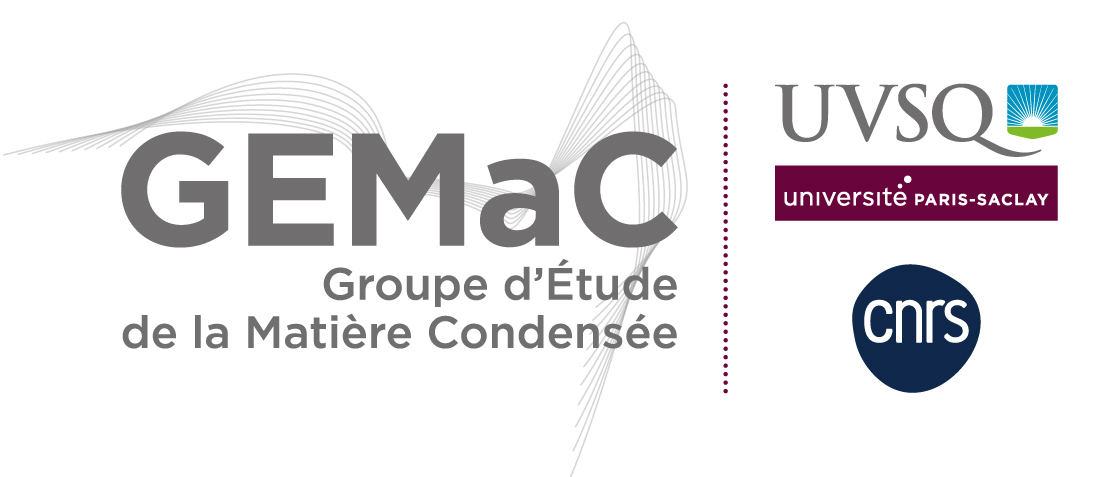You are here : GEMACENHighlights
- Partager cette page :
- PDF version
A series of discoveries about the incredible conductive and transparent materials known as vanadates.
Strontium and calcium vanadates (SrVO3 and CaVO3) are perovskite oxides. They are materials with multiple potential functions and applications. Here is an overview of recent advances, to which GEMaC has made a major contribution.
The perovskite oxide SrVO3 is a highly correlated electron metal of growing interest to the scientific community. It is a model material for testing different theories of the origin of the metallic state, the metal/insulator transition and the associated exceptional electronic properties [1,2]. In this context, GEMaC is optimising the thin film growth of this material and its 'almost' twin CaVO3 by laser ablation (PLD). This approach has led to the gradual discovery of the various functional and application facets of these compounds.
- Materials that are simultaneously transparent and electrically conductive are rare. Yet their applications are numerous (photovoltaics, screens, etc.). Vanadates possess this dual property. GEMaC has thus helped to demonstrate that these materials are promising as conductive and transparent electrodes for photovoltaics. Using nanosheets as growth seeds, the researchers succeeded in crystallising SrVO3 and CaVO3 thin films with very good electronic properties on a glass substrate at low temperatures [3].
- In addition, a detailed study of the PLD deposition conditions has shown the appearance of insulating nanostructures [4-5] that can be used as nano-capacitors [6]. Researchers have also recently demonstrated that the morphology of these nanostructures can be controlled by the orientation of the substrate. This offers control over the fabrication of the nanostructures, making it possible to target very specific applications (anti-reflection optical layer or control of surface wettability) [7].
- Finally, the dissolution of SrVO3 and CaVO3 films has been observed in aqueous media [8-9]. This ability, which is still being studied in collaboration with the EPI team at ILV, allows them to be used in new nanofabrication processes. They can be used as sacrificial layers for the transfer of perovskite oxide thin films and heterostructures onto silicon, glass or flexible substrates. A proof of concept, published in 2020 [10], offers a wide field of study for the coming years.
In summary, the increasing mastery of vanadate growth opens the way to an ever-increasing number of applications, both fundamental and technological.
Related links:
Highlight of the CNRS Institute of Chemistry (INC)
Podcast radio France Culture
Pour la Science n°532 (26 janvier 2022), "Sur la piste de nouveaux matériaux conducteurs transparents"
References:
[1] S. Bakes et al.,
"Hubbard band versus oxygen vacancy states in the correlated electron metal SrVO3",
Physical Review B 94, 241110 (2016) – [arXiv]
[2] A. Fouchet et al.,
"Study of the electronic phase transition with low dimensionality in srVO3 thin films",
Materials Science and Engineering B, 212, 7 (2016) – [HAL]
[3] A. Boileau et al.,
"Highly Transparent and Conductive Indium-Free Vanadates Crystallized at Reduced Temperature on Glass Using a 2D Transparent Nanosheet Seed Layer",
Adv. Funct. Mater. 2108047 (2021) – [HAL]
[4] B. Berini et al.,
"Control of high quality SrVO3 electrode in oxidizing atmosphere",
Advanced Materials Interface 3, 1600274 (2016) – [HAL]
[5] R. Coq Germanicus et al.,
"Three dimensional resistance mapping of self-organized Sr3V2O8 nanorods on metallic perovskite SrVO3 matrix",
Applied surface science, 510, 145522 (2020) – [HAL]
[6] V. Demange et al.,
"Ca3(VO4)2 Nanowires on Metallic CaVO3 Films as Nanocapacitors",
ACS Appl. Nano Mater. 3, 6684 (2020) – [HAL]
[7] B. Berini et al.,
"Morphology control of self-organised Sr3V2O8 nanostructures on SrVO3 grown onto single and poly-crystalline subjacent SrTiO3 substrates",
Applied Surface Science 566, 150759 (2021) – [HAL]
[8] Y. Bourlier et al.,
"Surface characterizations and selective etching of Sr-rich segregation on top of SrVO3 thin-films grown by pulsed laser deposition",
ChemNanoMat 5, 674 (2019) – [HAL]
[9] Y. Bourlier et al.,
"XPS monitoring of SrVO3 thin films from demixing to air ageing: The asset of treatment in water",
Applied Surface Science, 553, 149536 (2021) – [HAL]
[10] Y. Bourlier et al.,
"Transfer of Epitaxial SrTiO3 Nanothick Layers Using Water-Soluble Sacrificial Perovskite Oxide",
ACS Applied Materials et Interfaces 12, 8466 (2020) – [HAL]
Contact :
Bruno Berini
Yves Dumont





